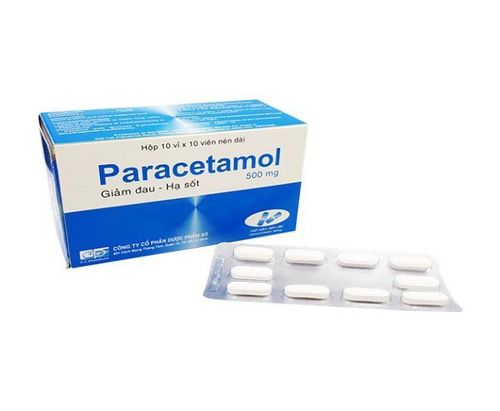This is an automatically translated article.
Stomazol drug with the main ingredient is Esomeprazole, used in the treatment of gastrointestinal diseases such as: Gastroesophageal reflux disease, prevention of recurrence of peptic ulcer, Zollinger Ellison syndrome,. .. So how should Stomazol be used?
1. What is Stomazol?
Stomazol drugs belong to the group of gastrointestinal drugs, made in the form of hard capsules and packed in boxes of 3 blisters, boxes of 10 blisters x 10 tablets.
Stomazol 20 with the main ingredient is Esomeprazole (in the form of Esomeprazole (Esomeprazole magnesium trihydrate) 8.5% enteric-soluble microparticles) 20mg and other excipients just enough for 1 tablet.
Stomazol 40 with the main ingredient is Esomeprazole (in the form of Esomeprazole (Esomeprazole magnesium trihydrate) 8.5% enteric-soluble microparticles) 40mg and other excipients just enough for 1 tablet.
2. Indications for using Stomazol
Stomazol drug used for adults in the following cases:
Gastroesophageal reflux disease (GERD): Treatment of erosive reflux esophagitis, long-term treatment for patients with healed esophagitis to Prevention of recurrence, symptomatic treatment of gastroesophageal reflux disease (GERD) Stomazol in combination with an appropriate antibacterial regimen for the eradication of Helicobacter pylori and healing of duodenal ulcers associated with Helicobacter pylori infection and Prevention Gastroduodenal ulcer recurrence in ulcer patients infected with Helicobacter pylori. The patient needs continuous treatment with non-steroidal anti-inflammatory drugs (NSAIDs) to heal stomach ulcers caused by taking NSAIDs. Prevention of gastric and duodenal ulcers associated with NSAID use in patients at risk. Prolonged treatment with Stomazol after intravenous prophylaxis of peptic ulcer rebleeding has been given. Treatment of Zollinger Ellison syndrome. Stomazol drug used for adolescents 12 years of age and older:
Gastroesophageal reflux disease (GERD): Stomazol is used to treat inflammation of the esophagus caused by reflux. Long-term Stomazol treatment for patients with healed esophagitis to prevent recurrence. Symptomatic treatment of gastroesophageal reflux disease (GERD): Combination of Stomazol with antibiotics in the treatment of duodenal ulcers caused by Helicobacter pylori.
3. Dosage - How to take Stomazol
Stomazol is used orally. Stomazol is prescribed by a doctor, so patients should not self-medicate, strictly follow the instructions from a medical professional.
Dosage of Stomazol refer to the following:
Duodenal ulcer 20mg Esomeprazole /day x 2-4 weeks. Gastric ulcer & reflux esophagitis 20 mg Esomeprazole/day x 4-8 weeks. Esomeprazole may be increased to 40 mg/day in patients resistant to other therapies. Zollinger-Ellison syndrome 60 mg Esomeprazole/day. Prophylaxis of recurrent gastric and duodenal ulcers 20-40mg Esomeprazole/day.
4. Contraindications to the use of Stomazol
Stomazol drug should not be used in cases where the patient has a history of hypersensitivity, allergy to esomeprazole, benzimidazole subgroup or to any of the excipients in the formulation.
5. Stomazol drug interactions
There have been reports of drug interactions Stomazol when co-administered with diazepam, imipramine, citalopam, imipram, clomipramine, phenytoin,... plasma concentrations of these drugs may increase and dose reduction is required due to inhibition of esomeprazole inhibits CYP2C19, the main enzyme that metabolizes esomeprazole.
To ensure safety when using Stomazol for treatment, patients should list all the current medications and other medical conditions they are having to their doctor, so that they have the most effective and safest direction to use Stomazol.
6. Side effects when using Stomazol
During the use of Stomazol, patients may experience some undesirable side effects that have been reported as follows:
Common: Headache, abdominal pain, constipation, diarrhea, flatulence, nausea/vomiting. Uncommon: Dry mouth, dermatitis, urticaria, skin pruritus, dizziness. Rare: Hypersensitivity reactions, angioedema, anaphylactic reactions, elevated liver enzymes. The following adverse events have been reported for the racemic mixture (omeprazole) and may occur with esomeprazole:
Central and peripheral nervous system: Paresthesia, reversible mental confusion, depression , temper, drowsiness, insomnia, dizziness, agitation, hallucinations mainly in critically ill patients. Endocrine: Gynecomastia. Gastrointestinal: Gastrointestinal candidiasis, stomatitis. Hematology: Thrombocytopenia & leukopenia, agranulocytosis and pancytopenia. Liver: Elevated liver enzymes, encephalopathy in patients with previous severe liver disease, hepatitis with or without jaundice, liver failure. Musculoskeletal: Muscle weakness, arthralgia and myalgia. Skin: Rash, photosensitivity, erythema multiforme, Stevens-Johnson syndrome, toxic epidermal necrolysis (TEN), alopecia. Other adverse reactions when using Stomazol drugs such as: Fatigue, hypersensitivity reactions such as, interstitial nephritis, angioedema, fever, bronchospasm, increased sweating, peripheral edema, hyponatremia, blurred vision disordered taste. Patients should inform their doctor or treatment of all symptoms/manifestations suspected of side effects of Stomazol for timely examination and treatment.
7. Precautions when using Stomazol
Use Stomazol with caution in pregnant and lactating women.
Patients should be excluded from malignancy in case of suspected gastric ulcer before using Stomazol for treatment.
Do not use Stomazol after the expiry date listed on the product packaging.
Stomazol is prescribed by a doctor, patients do not arbitrarily use Stomazol without indications.













